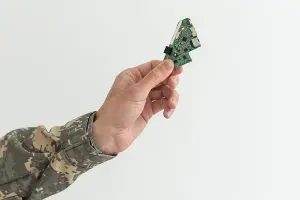Meeting Military Standards (MIL-STD) in Electronic Manufacturing
Manufacturing electronic components for military use involves meeting an additional level of stringent standards and requirements. When producing technology for the Department of Defense, every component must be built to perform reliably—even in the most extreme conditions. These high standards apply to a wide range of systems, including communication, navigation, aerospace, shipboard, computing platforms, and mission-critical equipment such as weapons control systems. To ensure consistency and performance, the Department of Defense has established rigorous military standards for all electronic parts. Developers and manufacturers must be fully prepared to meet these demanding quality and performance expectations.
What are Military Standard Electronics?
If you’re involved in electronic manufacturing for the Department of Defense, it’s important to understand key military terminology—starting with MIL-STD, which stands for military standard. These standards ensure that every component used in military or Department of Defense electronic devices meets the highest levels of performance and quality. Originally developed after World War II and updated in 2011 to reflect modern technology, MIL-STD requirements are critical for maintaining reliability in mission-critical environments. There are five main categories of military standards, each designed to ensure consistent performance and dependable functionality across military equipment. These categories include:
- Interface Standards
- Design Criteria Standards
- Manufacturing Process Standards
- Standard Practices
- Test Method Standards
When the standards were updated in 2011, the Supply Chain Hardware Integrity for Electronics Defense (SHIELD) program was instituted, intended to safeguard against tampering or removal of electronic components. This is where ECMs need to make sure that they understand all the standards as they relate to PCB components.

Traceability Requirements
Every electronic component should be traceable, but when adhering to MIL-STD requirements, traceability requirements are even higher. Everything that goes into the production process must be documented, particularly for component procurement. This is one of the reasons it is so crucial to have a trusted network of vetted suppliers who can hold up to DoD requirements for component sourcing.
Requirements for Reliability
Military electronics need to be reliable under any condition. MIL-STD-461G, simply put, requires an electronic component to tolerate certain interferences that may be present in DoD missions. The tests required for this standard include a test to ensure that radiated emissions don’t exceed specified limits, that electrical noise generated will not impact the performance of other systems, that the device will continue to operate even when exposed to strong electromagnetic fields, and the electronics will be resistant to disturbances.
Requirements for Ruggedness
MIL-STD electronics not only have stricter quality control and requirements for reliability, but have much higher performance standards than many consumer electronics. Although it varies by industry, military-grade electronics will need to demonstrate ruggedness and have the ability to perform under extreme operating conditions, such as extreme temperatures, pressure, and shock. Proof of long-term durability under these conditions needs to be established with comprehensive testing. These electronic components will also need to have enhanced security measures to make them tamper-proof.
Environmental Testing Requirements
The testing process is not about whether or not the device will function appropriately in the clean and sterile environment of the manufacturer, but if it can hold up to the true operating conditions. To ensure compliance with MIL-STD regulations, environmental testing, where the operating environment can be effectively simulated, is essential to verify reliability and ruggedness.
Meeting Compliance Throughout the Entire ECM Process
Meeting military standards cannot only be the focus of the quality control or testing phase of the process. To be a compliant military electronic manufacturer, the standards will need to be referenced at every stage. During the design process, the materials and components should be selected to avoid supply chain issues and ensure traceability. Layout, grounding, and shielding will also need to be addressed at this stage. Early testing, typically by developing a working prototype, will help identify and mitigate potential issues early. Throughout every stage, detailed documentation of design decisions, material selection and procurement, test results, and changes is essential to stay compliant. Using an accredited testing facility can provide unbiased and trusted reports that are necessary for certification.
What Electronic Contract Manufacturers Need to Know
In order to meet MIL-STD requirements, electronic contract manufacturers will undergo testing and auditing processes to ensure they are within compliance. This rigorous process consists of adherence to testing methodologies, quality control measures, and specific manufacturing processes, all of which are outlined in the MIL-STD regulations. For most ECMs, this adherence to the standards can be achieved through certifications and maintained through periodic reviews and audits. It is important that ECMs involved in PCB assembly and electronic manufacturing for the DoD stay updated with the latest requirements, which can change as technology continues to advance. In addition to meeting the standards through certifications, undergoing continuous training is not only a way to keep up with standards that evolve with technology advancements, but will also ensure that everyone working with a particular project is on the same page with the requirements.
Meeting military standards is not easy. For an ECM to meet the MIL-STD requirements, they will need to be up to date on all relevant certifications, have exceptional component traceability and a network of trusted and vetted suppliers, and be able to demonstrate a well- documented and comprehensive quality control process that will ensure that every component has the functionality, reliability, and durability to be trusted in extreme operating environments. If the equipment can have life-or-death consequences, there is no room for error, and military standards are there to keep even the potential for errors as limited as possible.
Meeting MIL-STD requirements in electronic manufacturing is no small task—it demands a deep understanding of evolving standards, strict adherence to compliance protocols, and an unwavering commitment to quality, traceability, and performance. From design and component sourcing to testing and certification, every step in the process must be executed with precision and accountability. For ECMs serving the Department of Defense, staying current with regulations, maintaining robust supplier networks, and fostering a culture of continuous improvement are not just best practices—they’re essential. In a field where failure is not an option, meeting military standards isn’t just about passing tests; it’s about delivering mission-critical reliability when it matters most. Contact Levison Enterprises to learn more about how we can help you with your next build.
Start Your Quote Now!